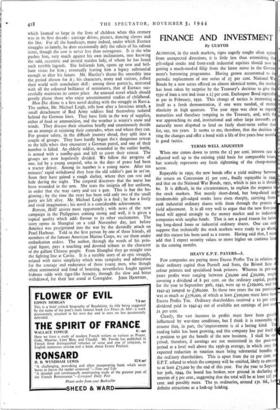FINANCE AND INVESTMENT
By CUSTOS
ALTHOUGH, in the stock markets, signs eagerly sought often ap from unexpected directions, it is little less than astonishing th gilt-edged stocks and front-rank industrial equities should now getting a much-needed fillip from the latest move in the Govern ment's borrowing programme. Having grown accustomed to th periodic replacement of one series of 21 per cent. National W Bonds by a new series offered on almost identical terms, the mark has been taken by surprise by the Treasury's decision to give th type of loan a rest and issue a x per cent. Exchequer Bond repayabl at par in February, 195o. This change of tactics is interesting itself as a fresh demonstration, if one were needed, of men elasticity in high quarters. The year 1950 was clear as regar maturities and therefore tempting to the Treasury, and, with th war approaching its end, institutional and other large investdts ar naturally more disposed to lend on fairly short-term rather th for, say, ten years. It seems to me, therefore, that the decision ring the changes and offer a bond with a life of five years four mon is good tactics.
TERMS WELL ADJUSTED When one comes down to terms the zi per cent.- interest rate i adjusted well up to the existing yield basis for comparable issues but scarcely represents any fresh tightening of the cheap-mono screw.
Repayable in 1950, the new bonds offer a yield midway betwee the return on Conversion 2} per cent , finally repayable in 1949 and that on the National War Bonds, 1951, which is just as it shoul be. It is difficult, in the circumstances, to explain the response I the stock markets. Not merely short-dated, but long-dated an irredeemable gilt-edged stocks have risen sharply, carrying fron rank industrial ordinary shares with them through the process yield adjustment. It is all very well to argue that the new ire-ye bond will appeal strongly to the money market and to inciustri companies with surplus funds. That is not a good reason for hoist ing long-dated loans or industrial ordinary shares. One can onl suppose that technically the stock markets were ready to go ahca and this excuse his been used as a reason. Having said that, I mus add that I expect security values to move higher on cautious line in the coming months.
HEAVY E.P.T. PAYERS-3.
Few companies are paying more Excess Profits Tax in relation their ordinary capital than Purnell and Sons, the Bristol firm colour printers and specialised book printers. Whereas in pre-w years profits were ranging between L30,000 and L50,000, amp covering a dividend of 8 per cent. on the ordinary capital, profi for the year to September 3oth, 1942, were up to £229,000, and f 1942-43 jumped to £380,000. In these two years the tax provis was as much as £576,000, of which at least £5oo,000 must have be Excess Profits Tax. Ordinary shareholders received a to per cen dividend paid in 1942-43 out of available net earnings of just os 21 per cent.
Clearly, the vast increase in profits must have been great! influenced by war-time conditions, but I think it is reasonable t assume that, in part, the `improvement is of a lasting kind. Th reading habit has been groWing, and this company has put itself a position to get the benefit of the new business. I shall be sur prised, therefore, if earnings are not maintained in the post- period at a level well above the 1936-39 average, in which case expected reduction in taxation must bring substantial benefits t the ordinary shareholders. This is apart from the to per Cent. 0 E.P.T. refund to which the company will be entitled, likely to amo to at least £75,000 by the end of this year. For the year to Septe ber 30th, 1944, the board has broken, new ground in declaring interim of 5 per cent, suggesting that the total will be at least z21 cent. and possibly more. The 5s. ordinaries, around 133. 6d., h definite attractions as a lock-up holding.


























 Previous page
Previous page